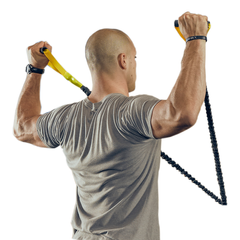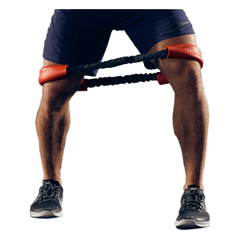Take some time to get to know your shoulder.
With a general understanding you’ll be ready to dive deeper into why it hurts and ways to fix it.
Shoulder Anatomy– “The Framework”
First, get to know the bones of your shoulder. They are the scaffolding that supports the entire structure, similar to a wood frame for a house.

The spine and rib cage create the shoulder foundation.. While technically these structures are not the shoulder, they do add a ton to its structure and movement.
You can easily feel the impact that the spine has on your shoulders by slumping your chest forward as far as you possibly can and then lifting your arms as high as you can overhead. You’ll notice that they get stuck earlier versus sitting tall with the chest up and spine extended.
The same goes with rotation. Look over your shoulder and try to reach something you see without turning your shoulders. You’ll have much greater success with the range of motion achieved by rotating your spine.
Thus, you need your spine to extend, bend, and rotate to accomplish the many different movement tasks demanded of the shoulders. This becomes especially important in sports and workouts that require greater speeds and heavy loads.
The big take-home is that often the shoulder relies on the body's posture to put it in a position to work most effectively. But for the classic shoulder bones, it comes down to three that make up the joint.
1. The Clavicle
Next on the list of supportive bones is the clavicle.
This creates a support beam to the shoulder and is the one bony attachment of the shoulder complex to the frame of the body.

2. The Scapula
Next is the scapula, also known as the shoulder blade, or sometimes called the scap.
The scapula hangs off the end of the clavicle and against the rib cage, held in place by 17 different muscles. Those muscles act as guide-wires, pulling the shoulder blade into various positions.
On the outer corner of the triangle is the insertion point for the arm bone and what most consider their shoulder socket.

Before moving onward, move your shoulder blade around a bit. Notice how the arm moves along with it. The term used to describe how the scapula and arm move together is scapulo-humeral rhythm. The key word rhythm describes the movement of two things in synchrony.
This is all too important for the shoulder. The scapula and arm must work together as a team, otherwise, it’s just a half working shoulder. What I’m getting at, is your fix for shoulder pain, or building arm strength, must include the muscles that move the scapula as well.
3. The Humerus

And finally, we’re at the true shoulder, and where most locate their pain. The arm bone (or humerus) attaches to the shoulder socket via a ball, hence the phrase ball and socket joint.
However, the ball of the arm bone is much larger than the socket, often described as a golf ball sitting on a tee. The advantage of this is movement! The shoulder isn’t bound up but can move freely in many different directions.

The Shoulder Trade-Off
In summary, the shoulder is highly capable of movement.
It can go fast, for things like throwing, or it can exert force in many ways for things like lifting weights or carrying bags of dog food, or it can be very precise to catch something tossed your way.
Compared to the hip, it’s much less clunky. Free to wave around like those tube dancers that jive in front of used car lots.
As with anything, though, there is a trade-off. And despite the luxury to move in so many ways, it brings about a problem of holding it all together, and actually where many problems creep in for the shoulder.
Holding it Together
The bones of the shoulder are held together by a combination of tissues that are classified as either static or dynamic stabilizers. What I like to describe as tape and rubber bands.
The tape describes the static stabilizers. Things that don’t move and aren’t all that stretchy. They do a good job of holding things in place. The most talked-about static stabilizers are the ligaments and the labrum of the shoulder.
We won’t talk much about the static stabilizers other than you can’t do much to change them and they don’t repair themselves. So when things go wrong, you’ll need to focus on the things that you can change (i.e.- the rubber bands.)
The rubber bands are the dynamic stabilizers that are muscles and their tendon attachments. They hold things together, but also lengthen and shorten to make the arm move.
The dynamic stabilizers can be strengthened and trained to improve their function, and are the primary target of a rehab program.
Therapy & Movement of the Shoulder
In an era of limitless information on the internet, it is easy to get sucked down a rabbit hole looking at all the structures that could be contributing to your shoulder pain. Pretty soon you might feel overwhelmed with all the areas to stretch, strengthen, mobilize and get treated by any number of “professionals”. The process can be exhausting, confusing, and even scary at times.
But like most things—You can’t believe everything you read on the internet.
Healing is largely a natural process that the body is designed to do without needing the perfect prescription of exercises. For most conditions, the pain will go away if you stop irritating it.
The thing is, if you appropriately screen all the red flags, strength and mobility are likely to take care of 90% of basic shoulder pain issues. It is really that simple. Give your body the opportunity to heal and work on mobility and strength— your body will take care of the rest.
We are going to show you how to do this on your own as a self rehab program, but first take a look at the different ways the shoulder moves.
Small Movements
Now let’s break this all down a bit more. Have you ever noticed even if you have a “shoulder issue” that some movements are actually just fine?
Small movements that mainly occur below shoulder height like picking up your cup of coffee, or typing at your desk feel ok but bigger movements like reaching up overhead seem to set your shoulder off a bit more? This gives a lot of information into what might be going wrong.
When making a small movement when your arm is close to your body it mainly happens by the ball of the arm moving in the socket. These actions rely on the four smaller shoulder muscles around the joint called the rotator cuff.

Big Movements
Now things get a bit more complex. As movements progress away from the body or overhead, it requires more moving pieces.
For things like washing your hair, reaching into the backseat of the car, or opening the overhead bin on an airplane, only so much can happen with the ball moving around the socket. To achieve the extra range of motion, the scapula needs to move simultaneously and in sync with the arm to free up additional ranges of motion and your rotator cuff has to keep the ball in the socket.
In order for your arm to create these bigger movements your shoulder blades need to move and create a foundation to support the load. Several muscles pull from opposing sides to pivot the scap for this action to happen. Moving the scap aligns the shoulder blade with the elevating arm bone and creates a stable support structure for the arm.
So not only do you need your shoulder blade to move well (while being stable) you also need the rotator cuff to be working in different directions. So big movements create more complex needs from our bodies.
Another reason to explain why sometimes small movements feel OK but big movements when your arm is up and out can be more painful or take longer to heal—it is a combined movement that needs a few layers of strength and stability.

Even Bigger Movements
What about moving heavy weight, pull-ups, and throwing fastballs?
Everything we've mentioned so far creates a foundation of strength, function and control for adding the additional pieces needed for high-performance. If you have proper synergy of the scapula moving through a full range of motion, and the rotator cuff effectively keeps the ball in the socket, the rest relies on proper form and strength of the prime movers.
Those are the workhorses responsible for strength and power. These are the muscles we hit in the gym—things like the pecs, deltoids, and lats.

Summing it Up
Working the remote or eating cheeseburgers doesn’t require too much from the shoulder. If this is your only goal, there probably isn’t much reason to worry. But to have an active life, as you can see, there are lots of working pieces that need to be strong and coordinated.
So when pain pops up, it’s usually because your strength or mobility isn’t meeting the demands. Future articles in this series will apply this understanding of shoulder anatomy and movement to explain the many shoulder breakdowns, how pain flares up, and put you on a path to fix it.
But before you begin, take the Red Flag Shoulder Screen to check for more complicated issues that need to be addressed by a medical professional.
Once you confirm that you’re all set for self-rehab, you can learn more about the different shoulder pain issues, or jump straight to one if you already have a diagnosis.
 Shoulder Packages
Shoulder Packages
 Hip & Core Package
Hip & Core Package
 NEW - Crossover TORQ
NEW - Crossover TORQ
 Bundles
Bundles
 Accessories
Accessories

































